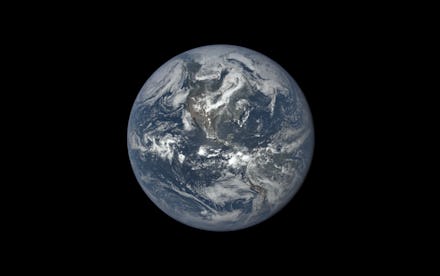You Can Now Watch the Earth Rotate for a Year From a Million Miles Away in Under 3 Minutes

A camera on a satellite positioned a million miles away from Earth captured images around every two hours for an entire year. The National Aeronautics and Space Administration had the courtesy to convert over 3,000 pictures into a time-lapse video, so you can watch your home planet do its thing in less than three minutes.
You're welcome.
The camera, appropriately baptized "EPIC," sits on the National Oceanic and Atmospheric Administration's DSCOVR satellite.
NASA uploaded the time-lapse video to YouTube Wednesday. It's narrated by EPIC's lead scientist for the DSCOVR mission, Jay Herman, to soothing, Amélie-esque piano, aiding the existential reflection.
"The spacecraft always remains between the sun and the Earth, approximately 1 million miles away at a special gravitational balance point known as 'Lagrange 1,'" Herman says.
A Lagrangian point is a special spot between the Earth and sun, whereby the gravity of both holds an object (in this case the DSCOVR satellite) in the same position.
"From this view, EPIC sees the sunrise in the West and the sunset in the East at least 13 times a day," Herman notes.
"The hourly images of the entire sunlit side of the Earth provided by EPIC will be used to study the daily variations of features over the entire globe, helping us to better understand — and protect — our home planet."
"EPIC takes at least one set of images about every two hours," he adds. "The camera records each set in 10 different wavelengths. At least three separate wavelengths — red, green and blue — are combined to produce this color view."
Around 1:52 the viewer can see the shadow of the moon move across the Earth during the solar eclipse in March.
"Changes in cloud cover affect the heat balance and how warm the Earth becomes, which is one of the reasons why we study them," Herman explains. "The hourly images of the entire sunlit side of the Earth provided by EPIC will be used to study the daily variations of features over the entire globe, helping us to better understand — and protect — our home planet."
What better reason to create something so beautiful?
Read more: